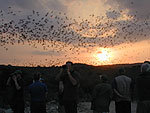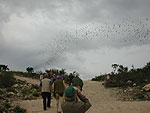
Bat-watching still popular, but its protection now key
Posted on 07/27/2002 1:32:43 PM PDT by MeekOneGOP

Bat-watching still popular, but its protection now key
07/28/2002
FREDERICKSBURG, Texas - They're heard long before they're seen. The sound mimics trickling water, chirping crickets and humming bees. They swarm more than 10,000 feet above the Hill Country, spiraling and zigzagging as the dawn arrives.
In a rush of wind, millions of Mexican free-tailed bats plunge into a tunnel returning to their roosts.
In Texas, bat-watchers troop every summer by the thousands to about a dozen sites such as the Congress Avenue Bridge in Austin or here at the Old Tunnel Wildlife Management area where the winged creatures live from March to October.
A cloud of more than 100 million bats builds over the Hill Country and South Texas each night. It is so large that it routinely appears on Doppler radar. Some of the bats explode out of the world's largest bat colony, Bracken Cave, near San Antonio.
| Also Online | |||||||||||||||||||||
|
|||||||||||||||||||||
But when they migrate south of the border for the winter, fear and superstition drive locals to kill them, even though they are crucial to the tequila industry. Leading scientists with Bat Conservation International which preserves and manages bat sites in Texas and Mexico are educating the public on the importance of bats to save several endangered species and preserve vital desert ecologies.
"All the tequila we have today we owe to the bats who have been pollinating the agaves for thousands of years," said Dr. Rodrigo A. Medellín, chairman of the international relations committee for the American Society of Mammalogists and a researcher at the Institute of Ecology at National University of Mexico.
The bats cross-pollinate the agave, a cactus that produces tequila juice. Without the pollination, the cactus will not produce healthy plants.
'Bat-friendly' area
North America is home to 148 of the world's nearly 1,000 species of bats. Of these, 140 live in Mexico, 45 in the United States, and 31 of those in Texas.
"It is amazing how many different bats and habitats there are" in Texas, said Meg Goodman, Texas' bat biologist and one of two full-time bat biologists in the country. "Other states are not as bat-friendly as this one."
The Hill Country teems with the cave-dwelling mammals as they raise their young. A road between Comfort and Fredericksburg leads past hundreds of deer, turkey, jackrabbits and other wildlife, to the town of Welfare.
There, the Old Tunnel Wildlife Management Area can be seen and smelled. It is home to about 3 million Mexican free-tailed bats. They are also known as guano bats because of their droppings, which can be used as a fertilizer.
Bats started using the 920-foot railroad tunnel in 1943, a year after it was abandoned by the Fredericksburg & Northern Railroad, said Kirby Carroll, wildlife biologist and manager of the sanctuary, which is part of the Texas Department of Parks and Wildlife.
At dusk, people gather on Big Hill in a small amphitheater to watch the bats spiral out of the tunnel in search of food. "When they see them fly, they are awestruck," he said.
The most impressive flights occur after the young begin to accompany the adults in late July and August. Kenneth and Annette Shearer of Allen visit Fredericksburg every summer. This time, they were searching for some nightlife.
"I can't believe we didn't come here before," said Ms. Shearer, on a recent weekend visit. "I've never seen anything like this before."
Comfort resident Robert Pankratz, a Kendall County deputy sheriff, has been visiting the bats for most of his life. "When we were kids, we'd park our cars and watch the bats fly out."
Volunteer Richard Parsons, 81, lectures every night, just before the bats whirl out like a tornado to hunt for food. He says the morning return "is much better than when they fly out at night because of the whizzing noise going through their wings. It is much faster than the emergence."
The bats have been clocked at up to 80 mph. "To see them fly at the speeds and hear the velocity of them fall from the sky is spectacular," Mr. Carroll said.
Protecting bats
To keep the bats coming back to Texas, conservation must be practiced on both sides of the border, Ms. Goodman said. Researchers in Texas and Mexico are working to protect the migrating bats from harm in Mexico.
Ms. Goodman spearheads training staff at public viewing areas under the direction of Texas Parks and Wildlife and the international bat center.
She also conducts bat research, workshops and training programs. "I am working on borderland education from Brownsville to Tijuana," she said.
Bats are among the continent's least-studied wildlife and have long been misunderstood and persecuted, researchers say. Their slow reproduction rate increases their risk. Each female gives birth to one pup between the first and third weeks of June.
For one of her first projects, Ms. Goodman conducted a two-week survey in Big Bend of the long-nosed bat, first listed as endangered in 1988. These pollinate the century plants, or agave palmeri, the base cactus for the tequila industry in Mexico.
More than 200,000 acres of agaves in Mexico are already dead after too much harvesting, poaching and bat extermination.
"We are trying to rescue the tequila industry using the bats, stopping poaching and creating bat-friendly tequila stamps for alcohol labels," said Dr. Medellín, a bat researcher at the Institute of Ecology, National University of Mexico. In some areas, armed guards have been posted to protect the sensitive plants.
Each plant produces its highest alcohol level after 10 years of growth. Then the plant dies. Stopping the decline of the agave depends on maintaining a solid bat population for pollination.
Every night the bats also eat tons of insects flying bugs, beetles and many moths harmful to crops. Research has shown that a half-ounce female free-tailed can consume her body weight nightly, which would be more than 200 tons of insects for 20 million bats.
Mexico's bat myths
Locals in some parts of Mexico have burned old tires or shot guns inside bat caves to drive away colonies.
Even minor disturbances such as entering or shining a light into the roost area can cause bats to abandon the caves, Dr. Medellín said.
As a result, 37 species of bats in Mexico are at risk of extinction. Five of the 10 largest populations of bats have declined by at least 60 percent in recent decades.
Numerous bat colonies have been wiped out.
"That gave us an alarm call," said Dr. Medellín. "Today the colonies we are monitoring are stable or increasing."
Vandalism and destruction of bat roosts stem from the fear, experts say.
Myths and legends from all over the world portray bats as blood-sucking vampires, or vampiros. The legend of the La Chupacabra, a stalking night creature that feeds on people, has been associated with bats and still lingers. "It is a cultural fear of the bats," said Bob Benson, a spokesman for Austin-based international bat center.
Three species of vampire bats in Central and South America feed on the blood of large birds, cattle, horses and pigs.
They use their sharp teeth to make cuts in the skin of a sleeping animal, then lap up the blood. Their saliva contains chemicals that keeps the blood from clotting and numbs the animal's skin.
Scientists say vampire bat saliva may help researchers prevent heart attacks and strokes. "The vampire bat's saliva attacks clotting cells and turns them into liquid," Dr. Medellín said. "And it doesn't have any side effects."
Education efforts
La Gruta, a cave in the state of Michoacan, Mexico, is home to 14 species of bats numbering less than 1 million, Dr. Medellín said.
"This cave has the most species in one cave in the world," he said, including large populations of free-tailed and some of the endangered long-nosed bats that migrate from Texas and New Mexico.
"Children in the area would gather fossils from the cave and then try to sell them to tourists, which was hurting the cave and disrupting the bats," he said.
It is around La Gruta that some of the most successful education efforts have taken root through the Program for the Conservation of Migratory Bats, Dr. Medellín said.
"We had to educate folks about bats. They associate all bats to the vampire bat," said Mr. Benson. "We created a bilingual series of books for children that were very well received. We did radio spots in Spanish. People started gaining appreciation for the bats. Parents started learning from the kids."
La Gruta is now in the hands of the community cave stewards who protect the cave, and the populations have been increasing.
Another Mexican cave, Cueva de la Boca, south of Monterrey, once housed a colony of 25 million bats, one of North America's largest. The population plummeted to 100,000 by 1991.
Conservationists started a restoration project, removing graffiti and trash. Today, the cave houses more than 2 million bats.
The Mexican government will establish the country's first bat sanctuary there by the end of the year, Dr. Medellín said.
The team already started a program at La Boca to address bat myths in the Mexican culture and teach children the importance of bats to ecology.
Children usually learn better when they have an emotional attachment to the subject, so the group created a mascot, Marcelo the friendly free-tailed bat.
"When we read the Marcelo story to the children, it was immediately apparent that they liked this friendly bat who lives and feeds in their neighborhood," Dr. Medellín said.
E-mail cconner@dallasnews.com


"All the tequila we have today we owe to the bats who have been pollinating the agaves for thousands of years. The bats cross-pollinate the agave, a cactus that produces tequila juice. Without the pollination, the cactus will not produce healthy plants."
Save the bats! Tequila is at risk without them!




The island I mentioned was out thru Ft. Amadore and was out beyond the entrance to the canal. It housed the 252nd Signal Company.
I remember once we had to go to the Atlantic side, Colon I think, on practice maneuvers for a few days. Well, when we weren't on duty we would take a jeep and a few of us would go into town to this tiny oceanside cabana and have a few beers. This particular evening as were talking, all of a sudden my buddy's beer just erupted out of his glass.
This humongous rinocerous beetle (I think) had fallen into it. This thing was HUGE and ugly! Scared the crap out of all of us. LOL!!!
Man do I have fond memories of Panama, I could go on all night.....Bats, snakes, ants, land crabs, iguanas......
I collect prints of bats from the 1700 to 1800s. Very lovely. I have them displayed in my guest bathroom ... otherwise known as the "guest bat-room".
Side effects being photophobia and an inability to see your reflection in the mirror.
Never trust a scientific study by some guy who french-kisses bats and then says the saliva is good for you...... UGH!!!
But when they migrate south of the border for the winter, fear and superstition drive locals to kill them, even though they are crucial to the tequila industry....Oh, my goodness! Forget about just protecting our bats, we gotta save the"All the tequila we have today we owe to the bats who have been pollinating the agaves for thousands of years. The bats cross-pollinate the agave, a cactus that produces tequila juice. Without the pollination, the cactus will not produce healthy plants."
Save the bats! Tequila is at risk without them!

LOL! ![]()
Disclaimer: Opinions posted on Free Republic are those of the individual posters and do not necessarily represent the opinion of Free Republic or its management. All materials posted herein are protected by copyright law and the exemption for fair use of copyrighted works.